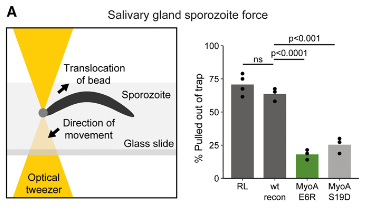Optical Tweezers (OT) method has emerged as a powerful and versatile tool in the study of malaria sporozoite motility. By utilizing focused laser beams, OT can trap and manipulate microscopic beads. Furthermore, by knowing the minimum escape force of the trapped bead, researchers may assess the forces generated by a single sporozoite interacting with the bead. In Malaria sporozoite, the actin-myosin interaction is a force generator that responsible for the parasite transmission. The phosphorylation of myosin-A protein dictates the actin-myosin interaction.
In a study conducted at the University of Heidelberg Medical School using the MMI CellManipulator Optical Tweezers, researchers discovered that the change in single amino-acid on the N-terminus of the myosin-A protein led to the lower force generation by sporozoites, hindering the parasite migration. More specifically, E6R (reverse change at position 6) and S19D (replacing the serine with a phosphomimetic aspartate at position 19) mutations.
This is to be expected. These two amino acids (i.e., E6 and S19) are crucial for transporting actin at maximum speed. Moreover, the ability of malaria-causing parasites to invade host cells depends on actin-myosin motor proteins. Without myosin phosphorylation, the parasites can’t colonize the mosquito salivary glands and are deficient in their migration. Even though point mutations of E6 and S19 hinder the force generation and parasite migration. Parasites still can normally infect mosquitoes.
Read the full publication
Discover CellManipulator Optical Tweezers
